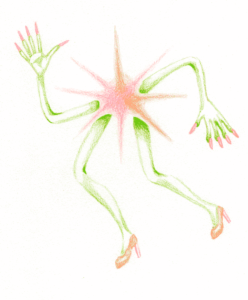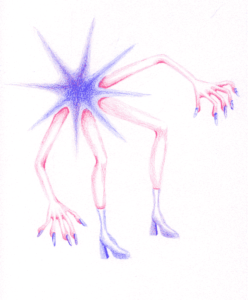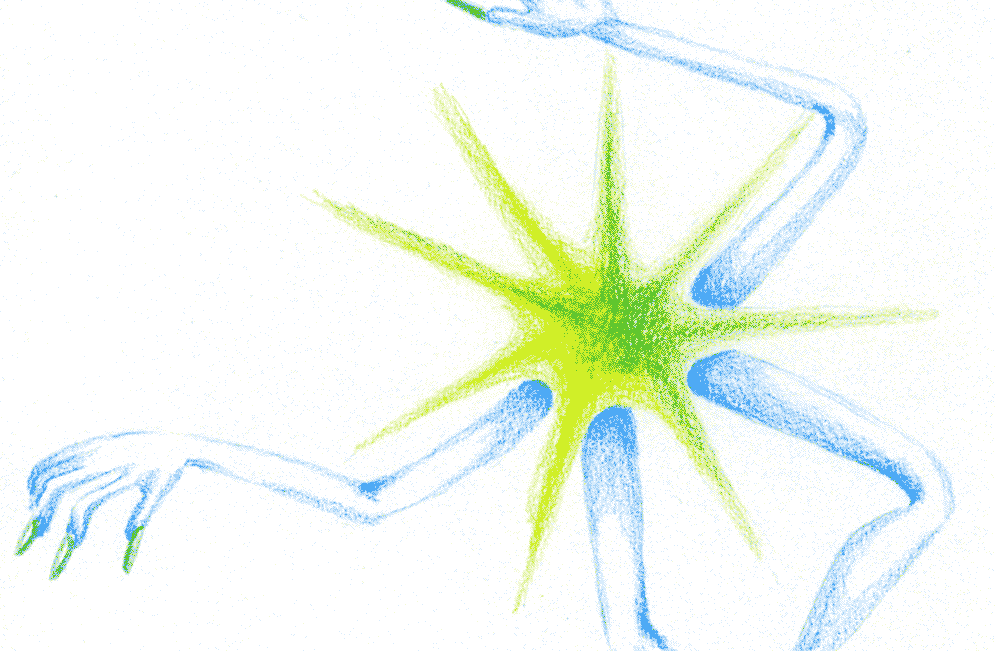We tend to look at the digital as something that we’ve still managed to keep separate from us — like there’s a distinct line between the digital and the physical, between flesh and silicon. What would happen if we brought these worlds together? Šari Dale’s Para-Social Butterfly lets that happen, and after a rush of lasers, shattered bones, micro-projectors, and twisted meat we get to the post-digital, post-physical world of our dreams.
It’s sexy, lonely, aesthetic, self-obsessed, ageless, horny, over-stimulating, satin, vegan, chrome, MySpace, Hyperpop, Ellen DeGeneres, purple neon, pixelated, ✨, and ?, and ?, and ??♂️?, and ?
It’s Ultra-Glam.

Para-Social Butterfly is autobiographical, and tells the story of how a disillusioned former waitress, Šari Dale, surgically implanted a projector in her brain and entered the .⚬♥*´-`*☆ULTRA-GLAM☆*´-`*♥⚬. She became a pop-star, fell in love with a 3D model of Timothee Chalamet crossed with Charlize Theron, went on the Ellen show, and still ended up feeling as empty inside as before. It’s a collection of poetry where emojis, ascii art, Ke$ha lyrics, and Paris Hilton’s Instagram comments make up poems that explore the nature of digital reality, the endless re-reproduction of art, and how difficult it is to connect with other people and ourselves.
Dale’s “Ultra-Glam” serves as the backdrop for the whole collection, and is one of the coolest representations of the internet age I’ve read in a while — it’s the digital landscape taken to its shiny, corporate, inevitable extreme. A world where God is the Instagram influencer that went on a trip to somewhere tropical once, stayed in a resort the whole time, and posts on their story about how deeply spiritual the experience was. A world where “Vibe isn’t antithetical / to virtue,” where “My life is pixels / and latent potential.”
Dale’s poetry explores who we become in the digital, in the Ultra-Glam. The poem “Cribs” describes what would probably be the best-ever episode of the MTV show, with the reader getting an insider’s look into Dale’s in-universe home. Where her “living room is a swamp of red satin,” and “The bedroom is a flowery little clusterfuck— / so many knicknacks,” where despite everything she accomplishes, no matter how many knicknacks or luxuries she collects, “all rubies still look like wounds.” In the Ultra-Glam, nothing will ever feel real enough, no matter how much you put on display — your viewers will always leave, and you could always end up alone; all this leading Dale to beg “Don’t leave just because the show is over… / You can always call me. Call me — promise you’ll call!”
The desperate melancholy of “Cribs” is present all throughout Para-Social Butterfly; the sense that, as the title implies, our relationships with other people will always be one-sided, and from that, that we will never have enough. In the Ultra-Glam, the people we interact with are never flesh-and-blood, there will always be a thick slab of glass and wire separating our flawed meat world from the ideal digital world we try to create And that’s scary, and sad, and lonely. But somehow, Para-Social Butterfly isn’t really any of those things.

The world that Dale creates, while bleak, still evokes everything that makes the digital world so enticing — why we’d want to enter the Ultra-Glam in the first place. It feels like the warm, comforting nostalgia of MySpace, Vaporwave, Flash games, Pictochat, and Tumblr. It feels like pop music from the early 2010s. It feels like the best of hyperpop, like art truly feeling new, exciting, and yours. Dale uses the language of the internet in a way that feels completely natural and not cringe. With writing punctuated by hashtags, skull emojis, bestie, haters, and, in one of my favourite poems of the collection (“The Ellen Degeneres Show”), Ellen Degeneres calling you a nasty little skrimlet. The whole collection is crushingly funny and feels amazing to read, never getting too bogged down in theory, critique, or reflection, while still benefiting from the depth of meaning they bring. For every poem like “Superstar” where Dale reflects on the self-loathing and insecurity inherent in creating art (“Call my art vapid, baby / Do it with conviction,” “Are you bored / at least I have a show. / I’m not some little loser. / […] I’m not some fucking loser!”), there is a “Trending,” a poem completely made up of hashtags that only the most insufferable person on Earth would use — “#paradisefound / #tropiclikeitshot / #restingbrunchface.”
Para-Social Butterfly explores what happens when the line between the digital and the physical begins to fade, and what makes it really special as a collection of poetry is that it really, and I mean really has something to say about that line. “Numbskull,” my favourite of the collection, is the moment when Dale enters the Ultra-Glam for the first time, when the line disappears — that moment is one of extreme violence. Dale describes herself in a public operating room, “Think Rembrandt’s Anatomy Lesson on a budget,” undergoing a bone-breaking, meat-twisting operation, and ends up begging, “Ultra-Glam, radiant simulation / let me in —.” The brutality required to enter the Ultra-Glam is a pop-soaked digitized banshee scream warning us what happens to our bodies when they’re torn apart into bits and ones and zeros — loneliness, amputation, and hyperreality. A world where real and unreal have blended into one.


